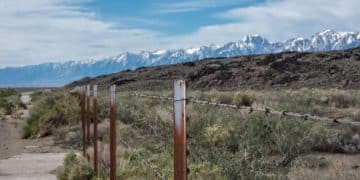Analyzing Social Media’s Impact: Is Political Discourse Polarized?

Analyzing the impact of social media on political discourse reveals increasing concerns that these platforms contribute to electorate polarization through echo chambers, filter bubbles, and the spread of misinformation.
The rise of social media has profoundly reshaped how we engage with politics. This article examines analyzing the impact of social media on political discourse, questioning whether it’s leading to a more polarized electorate in the United States.
The Evolution of Political Discourse in the Digital Age
Political discourse has undergone a significant transformation with the advent of the digital age. This section explores how social media platforms have changed the landscape of political communication, both positively and negatively.
From town hall meetings to Twitter threads, the way information is disseminated and debated has drastically evolved. The immediacy and reach of social media offer unprecedented opportunities for political engagement, but also present new challenges.
The Rise of Online Political Activism
Social media has become a powerful tool for political activism, enabling citizens to organize and mobilize around specific issues. Campaigns can spread rapidly, garnering support and attention in ways previously unimaginable.
Hashtag movements and online petitions have become common methods for expressing political views and demanding action from policymakers. This digital activism can amplify marginalized voices and facilitate direct engagement with political processes.
The Spread of Misinformation and “Fake News”
One of the most significant downsides of social media’s impact on politics is the ease with which misinformation can spread. False or misleading stories can quickly go viral, influencing public opinion and eroding trust in traditional news sources.
The lack of editorial oversight on many social media platforms allows fabricated content to proliferate, often targeting specific demographics or exploiting existing political divisions. This phenomenon poses a serious threat to informed democratic decision-making.
- Echo Chambers: Social media algorithms can create echo chambers where users are primarily exposed to information confirming their existing beliefs, reinforcing biases.
- Filter Bubbles: These personalized information environments limit exposure to diverse perspectives, further solidifying political polarization.
- The Role of Bots: Automated accounts can amplify misinformation and manipulate online conversations, making it difficult to discern authentic voices from fabricated narratives.
Social media’s evolution has both democratized and complicated political discourse. While offering avenues for increased engagement and activism, it also presents challenges related to misinformation and polarization. Understanding these dynamics is crucial for navigating the digital age effectively.
Analyzing Polarization on Social Media Platforms
Social media’s architecture and algorithms have been identified as potential drivers of political polarization. This section analyzes specific platform features that contribute to the division of opinions and the reinforcement of ideological silos.
Understanding how these platforms function is essential to addressing the challenges they pose to constructive political dialogue. The focus is on identifying the mechanisms that encourage division and impede cross-partisan understanding.
Algorithmic Amplification of Outrage
Social media algorithms are designed to maximize user engagement, often prioritizing content that evokes strong emotional responses. Outrage and anger tend to generate high levels of interaction, leading to their amplification and wider distribution.
This algorithmic bias can create a distorted perception of public opinion, as extreme viewpoints are disproportionately highlighted while moderate voices are drowned out. The result is a more polarized online environment that reinforces partisan animosity.
The Impact of Targeted Political Advertising
Social media platforms offer sophisticated targeting capabilities, allowing political advertisers to reach specific demographics with tailored messages. This can be used to mobilize voters or persuade undecided individuals.
However, targeted advertising can also exacerbate polarization by reinforcing existing biases and exploiting vulnerabilities. Misleading or inflammatory ads can be strategically deployed to stoke division and discourage constructive dialogue.
- Microtargeting: This technique involves tailoring political messages to extremely specific groups of individuals based on their demographic data, interests, and online behavior.
- A/B Testing: Political campaigns use A/B testing to determine which messages resonate most effectively with different audiences, allowing them to refine their strategies and maximize their impact.
- The Cambridge Analytica Scandal: This incident highlighted the potential for data breaches and misuse of personal information to manipulate political outcomes, raising concerns about privacy and democratic integrity.
Social media algorithms and advertising strategies play a significant role in shaping political discourse and potentially contributing to polarization. By understanding these mechanisms, we can better assess their impact and develop strategies to mitigate their negative effects. This knowledge is crucial for fostering a more inclusive and constructive online environment.
The Role of Social Media in Political Mobilization
Social media has become a vital tool for political mobilization, enabling individuals and organizations to organize, advocate, and participate in political processes. This section examines how social media facilitates collective action and influences political outcomes.
From grassroots movements to electoral campaigns, social media provides unprecedented opportunities for connecting with voters and amplifying political messages. However, it’s crucial to understand both the positive and negative aspects of this digital mobilization.
Organizing Protests and Demonstrations Online
Social media platforms have played a key role in coordinating protests and demonstrations, allowing activists to quickly mobilize large numbers of people around specific causes. Events can be organized and promoted online, bypassing traditional media channels.
This decentralized model of organizing empowers ordinary citizens to engage directly in political action, fostering a sense of community and shared purpose. The use of hashtags and viral content helps to raise awareness and attract attention to political issues.
Influencing Voter Turnout and Engagement
Social media is increasingly used to encourage voter turnout and engagement, particularly among young people and other demographics that are traditionally less likely to participate in elections. Campaigns can target specific groups with tailored messages and reminders.
Online voter registration drives and social media campaigns can help to overcome barriers to participation and increase civic engagement. The ability to share information and express opinions online can also foster a sense of collective responsibility and encourage political participation.
- Get-Out-The-Vote (GOTV) Campaigns: These campaigns leverage social media to remind eligible voters to register and cast their ballots, often providing information about polling locations and deadlines.
- Online Fundraising: Social media platforms have become essential tools for political fundraising, allowing candidates and organizations to solicit donations from a wide range of supporters.
- Social Media Influencers: Political campaigns are increasingly partnering with social media influencers to reach younger audiences and promote their messages in an authentic and relatable way.
Social media has revolutionized political mobilization, providing new avenues for collective action, voter engagement, and political influence. While offering significant opportunities for democratic participation, it’s important to be aware of the potential for manipulation and misinformation, ensuring that these tools are used responsibly and ethically.
Combating Misinformation and Promoting Media Literacy
Addressing the spread of misinformation on social media requires a multi-faceted approach that includes platform accountability, media literacy education, and fact-checking initiatives. This section explores strategies for combating false narratives and promoting more informed online discourse.
Empowering individuals to critically evaluate information and identify credible sources is essential for navigating the complex information landscape of the digital age. This involves raising awareness about common disinformation tactics and promoting media literacy skills.
Platform Accountability and Content Moderation
Social media platforms have a responsibility to moderate content and prevent the spread of misinformation. This involves developing clear policies, enforcing them consistently, and investing in resources to detect and remove false or misleading content.
However, content moderation is a complex issue, balancing the need to protect against harmful content with concerns about censorship and freedom of speech. Finding the right balance is essential for fostering a healthy online environment.
The Role of Fact-Checking Organizations
Fact-checking organizations play a critical role in verifying information and debunking false or misleading claims. These organizations use rigorous journalistic standards to assess the accuracy of statements made by politicians, public figures, and media outlets.
By providing evidence-based assessments of factual claims, fact-checkers help to inform the public and hold individuals and institutions accountable for spreading misinformation. Their work is essential for promoting more accurate and reliable information online.

- Media Literacy Education: Incorporating media literacy into school curricula can equip students with the skills to critically evaluate information, identify bias, and distinguish between credible and unreliable sources.
- Algorithmic Transparency: Greater transparency in how social media algorithms work can help users understand how information is filtered and prioritized, empowering them to make more informed choices about what they consume.
- Collaborative Efforts: Combating misinformation requires collaborative efforts between platforms, fact-checkers, educators, and policymakers to develop effective solutions and promote more responsible online behavior.
Combating misinformation and promoting media literacy are vital steps for addressing the challenges posed by social media to political discourse. By empowering individuals to critically evaluate information and holding platforms accountable for the content they host, we can create a more informed and constructive online environment.
The Impact on Political Campaigns and Elections
Social media has fundamentally transformed the landscape of political campaigns and elections, impacting everything from fundraising and voter outreach to messaging and advertising. This section explores the multifaceted ways in which social media influences electoral processes.
Candidates and political organizations now rely heavily on social media to connect with voters, mobilize supporters, and shape public opinion. Understanding the strategies and tactics used on these platforms is crucial for analyzing their broader impact on elections.
Social Media as a Campaigning Tool
Social media platforms offer a cost-effective way for candidates to reach a large audience, particularly younger voters who are active online. Campaigns can use social media to share their messages, engage with supporters, and respond to criticism.
The ability to target specific demographics with tailored advertising allows campaigns to maximize their impact and reach voters who are most likely to be persuaded. Social media also facilitates grassroots organizing and volunteer recruitment.
The Role of Social Media in Voter Mobilization
Social media is increasingly used to mobilize voters and encourage participation in elections. Campaigns can organize online voter registration drives, promote early voting, and provide information about polling locations and candidates.
Peer-to-peer communication and social sharing can amplify the impact of voter mobilization efforts, as individuals encourage their friends and family to participate. Social media can also be used to counter voter suppression efforts and ensure that eligible voters have access to the ballot box.
- Social Media Analytics: Political campaigns use social media analytics to track the performance of their content, identify influencers, and understand public sentiment.
- A/B Testing of Messaging: Campaigns use A/B testing to determine which messages resonate most effectively with different audiences, allowing them to refine their strategies and maximize their impact.
- The Use of Bots and Trolls: The presence of bots and trolls on social media can distort political discourse and spread misinformation, posing a challenge to informed democratic decision-making.
Social media has become an indispensable tool for political campaigns and elections, offering new opportunities for voter engagement, mobilization, and persuasion. However, it’s important to address the potential for manipulation and misinformation, ensuring that these platforms are used responsibly and ethically.
The Future of Political Discourse on Social Media
The future of political discourse on social media is uncertain, but likely to be shaped by ongoing debates about platform accountability, content moderation, and the spread of misinformation. This section explores potential trends and challenges that lie ahead.
As social media platforms continue to evolve and adapt to changing user behavior and technological innovations, it’s crucial to consider the implications for political communication and engagement. The focus is on identifying strategies to mitigate the negative effects and foster a more constructive online environment.
Emerging Technologies and Their Impact
Emerging technologies such as artificial intelligence (AI) and virtual reality (VR) are likely to play an increasingly important role in shaping political discourse on social media. AI-powered tools can be used to generate and disseminate content, target advertising, and moderate discussions.
VR technologies could create immersive political experiences, allowing voters to interact with candidates and explore policy issues in new ways. However, these technologies also raise ethical concerns about manipulation, bias, and the potential for creating even more personalized and polarized information environments.
The Need for Regulation and Oversight
The debate over regulation and oversight of social media platforms is likely to intensify in the coming years. Policymakers are grappling with how to balance the need to protect against harmful content and promote responsible online behavior with concerns about censorship and freedom of speech.
Potential regulatory measures include requiring platforms to be more transparent about their algorithms, establishing standards for content moderation, and holding them accountable for the spread of misinformation. Finding the right approach is essential for ensuring that social media platforms serve the public interest.
- Decentralized Social Media: The rise of decentralized social media platforms could offer an alternative to centralized, corporate-owned networks, empowering users and promoting greater control over their data and content.
- Digital Literacy Initiatives: Investing in digital literacy initiatives can equip individuals with the skills to critically evaluate information, identify bias, and participate responsibly in online discussions.
- Collaborative Solutions: Addressing the challenges of political discourse on social media requires collaborative solutions involving platforms, policymakers, educators, and civil society organizations.
The future of political discourse on social media will depend on how we address the challenges of misinformation, polarization, and platform accountability. By embracing digital literacy, promoting transparency, and fostering collaboration, we can create a more informed and constructive online environment that strengthens democratic processes.
| Key Point | Brief Description |
|---|---|
| 📣 Social Media Activism | Platforms facilitate organizing and mobilizing around political issues. |
| 🚨 Misinformation Spread | False information can quickly go viral, influencing public opinion. |
| 🤖 Algorithmic Bias | Algorithms amplify outrage, reinforcing partisan divisions. |
| 🗳️ Voter Mobilization | Social media encourages turnout, particularly among younger voters. |
What are the main concerns regarding social media’s influence on political discourse?
▼
Social media algorithms can create echo chambers and filter bubbles, exposing users only to information confirming their existing beliefs, leading to increased polarization and difficulty in understanding opposing viewpoints.
▼
Misinformation spreads rapidly on social media, influencing public opinion and eroding trust in traditional news sources. False or misleading stories often target specific demographics, exacerbating existing political divisions.
▼
Algorithms prioritize content that evokes strong emotional responses, often amplifying outrage and anger. This can distort the perception of public opinion, as extreme viewpoints are disproportionately highlighted, leading to a more polarized environment.
▼
Targeted advertising allows political campaigns to reach specific demographics with tailored messages, which can reinforce existing biases and exploit vulnerabilities. Misleading ads can stoke division and discourage constructive dialogue.
▼
Strategies include platform accountability, media literacy education, and fact-checking initiatives. Empowering individuals to critically evaluate information and identify credible sources is essential for navigating the digital age.
Conclusion
In conclusion, while social media offers unprecedented opportunities for political engagement and mobilization, it also presents significant challenges related to polarization, misinformation, and algorithmic bias. Addressing these issues requires a multi-faceted approach involving platform accountability, media literacy, and collaborative solutions.





